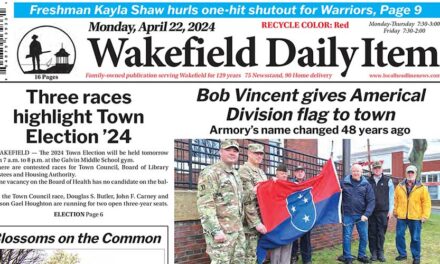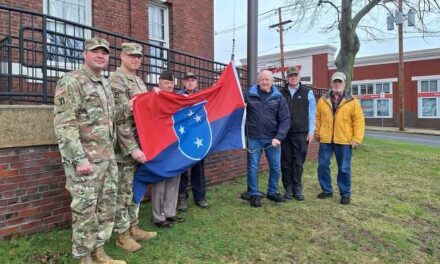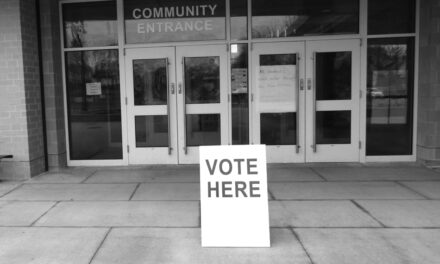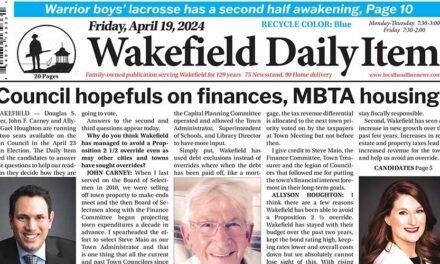Published in the June 24, 2021 edition.
By MARK SARDELLA
PEABODY — A four and a half hour community meeting Tuesday night to share information and solicit feedback on Project 2015A, Massachusetts Wholesale Electric Company’s (MMWEC) proposed 55 megawatt reliability resource to be sited in Peabody, turned into a forum for environmental activists who object to any plan that involves burning fossil fuels to generate any amount of electricity. Speakers also claimed that MMWEC has not been “transparent” in releasing details of the planned project.
MMWEC is the state’s not-for-profit agency for municipal light plants in Massachusetts. The Wakefield Municipal Light Department is one of 14 departments in MMWEC communities that has invested in the proposed Peabody “peaker” plant. The gas-fired plant would generate electricity only during periods of peak electricity usage — estimated to be about 239 hours per year — and enable the participating municipal light departments to meet capacity requirements in the New England market.
“Capacity” is defined as the ability to supply electricity at all times, including during periods of peak demand.
Tuesday’s meeting in Peabody featured a variety of speakers from MMWEC and member municipal light commissions, who argued for why the plant is needed. Wakefield Municipal Light Department General Manager Pete Dion spoke in favor of the plant as did Wakefield Light Commissioner Phil Courcy. Wakefield Town Council Chair Julie Smith-Galvin spoke in opposition to the plant.
All municipal light departments, as load-serving entities, are required to provide capacity to ISO New England, an independent nonprofit organization that oversees the operation of New England’s bulk electric power system. Capacity must be available to cover the light department’s peak load, plus a reserve margin.
Prices in the ISO New England capacity market are volatile, according to MMWEC, and Project 2015A locks in a price, protecting participating municipal light plants and their rate-payers against this price volatility.
According to MMWEC, as a capacity resource that is only used when needed to meet peak energy usage, Project 2015A will account for only 0.535% of project participant total energy needs. Energy is the amount of electricity used by the customers of an Municipal Light Department. Measured in kilowatt hours, energy usage varies through the year and the day.
Approximately 30 percent of MMWEC member capacity requirements are covered by entitlements from fossil resources and these capacity resources contribute less than 1.8% of total energy consumption for its members, MMWEC maintains.
MMWEC officials say that having the required capacity through Project 2015A frees municipal power companies to purchase or own more renewable energy, such as MMWEC solar Project 2020A, Berkshire Wind Phase I and Berkshire Wind Phase II.
The intermittent nature of renewable energy sources means they can provide very little capacity, according to MMWEC.
As a capacity and fast-start reserve resource, Project 2015A is estimated to run an average of only 2.72% of the time, equivalent to approximately 239 hours per year, during times of system stress or high energy usage.
MMWEC officials say that Project 2015A is expected to produce approximately 7,085 tons of carbon emissions per year. They maintain that Project 2015A will displace existing older, dirtier, fast-start plants when it is called upon to run, producing fewer emissions.
MMWEC contends that Project 2015A aligns with the Massachusetts Decarbonization Roadmap and that MMWEC members have been incorporating carbon-free power into their portfolios for decades, dating back to the 1980s. Having this capacity reliability resource helps participating municipal power companies stabilize rates and plan for the future, MMWEC maintains.
Wakefield MGLD General Manager Peter Dion stresses that as more renewables are layered into the energy system, the more critical it is to have a reliability resource like the proposed Peabody plant, to back up those resources.
“We just want to make sure the lights don’t go out,” he said. “We can’t be like Texas and California and shun the things we need.” Those states have faced severe power outages when demand for electricity outstripped the capacity to supply it.
“Breathe Clean North Shore” is a group that was formed to oppose the Project 2015A. The group has called upon MMWEC to “withdraw the proposal to move forward with this project and, instead, replace it with a project that will reduce the burden on the communities of Peabody and Danvers, and support participating Municipal Light Plants in becoming leaders of the Commonwealth’s transition to a clean, renewable future.”
Wakefield Town Council Chair Julie Smith-Galvin has been in the forefront of opposition to the Project 2015A plant. In a letter to the WMGLD commissioners, she applauds the advances WMGLD has made to adopt new and cleaner technologies. She insists, however, that, “This progress will be significantly diminished by investing in a dirty power plant that our children and grandchildren will have to pay for financially and environmentally. With the climate crisis nearing a point of no return, I implore the Commissioners of WMGLD to reevaluate this decision in light of the extraordinary climate, technology, legislative and regulatory changes that have occurred since this project first came before your Board.”
At Tuesday’s meeting in Peabody, she lamented the “lack of public input and transparency” around the project. She called the project “a setback for the climate and community trust.” She maintained that there are many more options available today than there were in 2015 when the project was first proposed. She also noted that the proposed plant would be located “within half a mile of at least two environmental justice populations.”
One of the alternatives floated by opponents involves solar power combined with battery storage.
But WMGLD General Manager Pete Dion pointed out that batteries require a much larger land area than is available at the proposed site. Batteries also have a fixed useful life. “Batteries are not a replacement for a resource such as this,” he said.
Wakefield Light Commissioner Phil Courcy spoke in favor of Project 2015A at Tuesday’s meeting in Peabody. He noted that while some light commissioners are “climate activists,” the majority of the Wakefield commissioners are in favor of the project for its ability to stabilize rates for WMGLD customers. The Light Commission’s priorities are “safe, reliable, affordable, clean power,” he said.
Dion addressed the “transparency” issue on the local level. He said that Project 2015A was discussed at public meetings of the WMLGD board in 2015, in 2017 and over a dozen times since. He said that the WMGLD and the Light Commission have done the same due diligence for this project as they have for all of the renewable projects that it has invested in. He noted that every project that the WMGLD has invested in in recent years had been a green project, except Project 2015A, which is only a backup for those renewable energy sources.
The video of Tuesday’s meeting on Project 2015A is available on the Peabody Municipal Light Plant’s Facebook page at facebook.com/PeabodyLight/.




